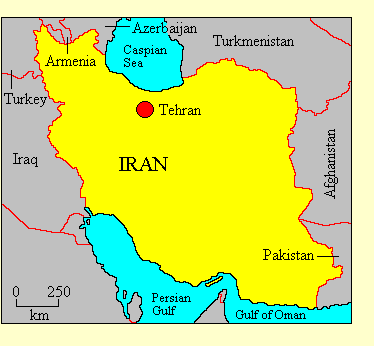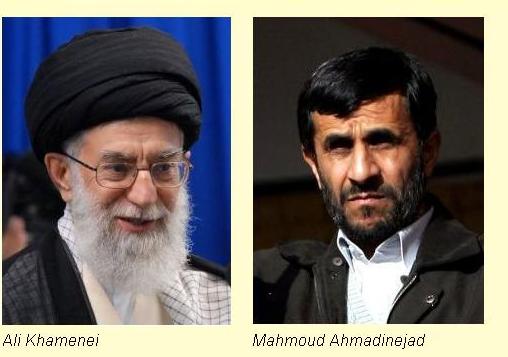

ISLAMIC REPUBLIC
OF IRAN
Official name: Jomhuri-ye Eslami-ye Iran (Islamic Republic of Iran)
• Location: Central Asia
• International organisations: Non-Aligned Movement, Organisation of Islamic Conference, Organisation of
Petroleum Exporting Countries, United Nations.
• Borders: Afghanistan, Armenia, Azerbaijan, Iraq, Pakistan, Turkey
• Coastline: Gulf of Oman, Persian Gulf
• Land area: 1,648,000 Km2
• Population: 74,200,000
• Annual GDP (PPP) per capita: US$12,900 (2009 CIA estimate). World ranking: 68
• Ethnicity: Iranian 51%, Azeri 24%, Gilaki and Mazandarani 8%, Kurdish 7%, Arab 3%
• Languages: Farsi or Persian is the official language, but is the
first language on only 58% of the population. The remainder speak
Azeri, Turkmen or other Turkic languages 26%, Kurdish or Arabic.
• Religion: Moslem 99% (Shi'a 89%, Sunni 10%). Shi'a Islam is the state
religion and the Islamic clergy are very powerful. There are small minorities of Zoroastrians, Jews, Christians, and Baha'i.
• Form of government: Iran is formally a presidential democratic
republic, but the Constitution gives supreme authority to unelected religious authorities. Iran is divided into 28 provinces.

• Capital: Tehran
• Constitution: The
Constitution of the Islamic Republic of Iran came into
effect on 2 December 1979, but has been substantially amended since.
• Supreme Leader: The Supreme Leader (Vali-e-Faghih) is appointed
for life by an assembly of Shi'a clergy, the Assembly of Experts. Ayatollah
Ali Hoseini-Khamenei has held this post since 1989.
• Head of state: The President, elected for a four-year term by
direct universal suffrage. Candidates for the presidency cannot
represent parties and must be approved by the religious authorities.
• Head of government: The President, who appoints the members of the
Cabinet.
• Legislature: The Islamic
Consultative Assembly (Majles-e-Shura-ye-Eslami) has 290 members,
elected for four-year terms from a mixture of single-member and
multi-member constituencies. There are no formal political parties and
candidates for election to the Assembly must be approved by the
religious authorities.
• Electoral authority: National elections are conducted by the government.
• Freedom House 2011 rating: Political Rights 7, Civil Liberties 7
• Transparency International Corruption Index: 22% (146 of 178 countries rated)
• Reporters Without Borders Press Freedom 2010 Index: 5.4% (175 of 178 countries rated)
• Heritage Foundation Economic Freedom 2010 Index: 42.1% (171 of 179 countries rated)
Political history
Iran, a traditional monarchy for many centuries, avoided colonial
rule in the 19th century by agreeing to modernise its institutions
under British supervision. A legislature was established in 1907 and
the forms of constitutional government observed, but real power
remained with the Shah, under the influence of foreign powers and
later of the oil companies. The Pahlavi dynasty seized the throne in
1921.
Mohammed Reza Pahlavi came to power in 1941, and attempted a
rapid westernising of the country, using the country's huge and
growing oil wealth to fund his grandiose projects. In the 1960s his
regime became increasingly autocratic and repressive. This provoked a
conservative backlash which culminated in the Islamic Revolution of
1979. The Shi'a religious leader, Ayatollah Ruhollah Khomeini, came
to power.

The Islamic Republic was at first supported by nearly all Iranians, but its
authoritarian rule, its restrictions on personal freedoms and its economic
incompetence have made it increaingly unpopular. Although the threat to the regime
from Marxist radicals has faded since a spate of bombings in the 1980s, there is widespread passive opposition.
Iran now presents a curious paradox: it is at
once an absolute theocracy, in which the Supreme Leader and the clergy
exercise power free from any legal restraint, and a presidential
republic in which reasonably free elections are held, although the religious authorities restrict who may contest them.
Despite regular elections, Iran is far from being a functioning democracy. Legislation passed by the Assembly can be, and
frequently is, invalidated by the self-appointed religious body, the
Council of Guardians. The government has little control over the police or the
religious courts, which arrest and sentence people, including members of the Assembly,
for vague offences such as "insulting Islam."
The efforts of President Mohammed Khatami (1997-2005) to reform the system were frustrated by the conservatives
with the backing of Ayatollah Khamenei, but he refused to place himself in opposition to the theocratic regime. In 2005 popular
anger at the deteriorating economic situation allowed the radical populist mayor of Teheran,
Mahmoud Ahmadinejad, to be elected President, defeating the establishment
candidate, former President Akbar Hashemi Rafsanjani. In office Ahmadinejad has disappointed his supporters by not touching clerical
corruption or reforming economic incompetence, and has responded to increasing unrest by becoming increasingly repressive and erratic.
His pursuit of atomic weapons and his threats to attack Israel have increased Iran's
international isolation. His re-election in 2009 over the reformist candidate Mir-Hossein Mousavi was blatantly rigged. This
sparked widespread and violent
protests, in which hundreds have died, and which have continued into 2010.
Freedom House's 2011
report on Iran
says: "Iran is not an electoral democracy. The most powerful figure in the government is the supreme
leader (Vali-e-Faghih), currently Ayatollah Ali Khamenei... The supreme leader, who has no fixed term, is
head of the armed forces and appoints the leaders of the judiciary, the chiefs of state broadcast media,
the commander of the IRGC, the Expediency Council, and half of the Council of Guardians. Although the
president and the parliament, both with four-year terms, are responsible for designating cabinet
ministers, the supreme leader exercises de facto control over appointments to the Ministries of Defense,
the Interior, and Intelligence. All candidates for the presidency and the 290-seat, unicameral parliament
are vetted by the Council of Guardians, which consists of six clergymen appointed by the supreme leader
and six civil law experts selected by the head of the judiciary, all for six-year terms... The Council of
Guardians also has the power to reject legislation approved by the parliament... Opposition politicians
and party groupings have faced especially harsh repression since the 2009 presidential election, with
many leaders facing arrest... Corruption is pervasive. The hard-line clerical establishment has grown
immensely wealthy through its control of tax-exempt foundations that monopolise many sectors of the
economy... Freedom of expression is severely limited. The government directly controls all television
and radio broadcasting... Iran leads the world in the number of jailed journalists...
Religious freedom is limited... The constitution recognises Zoroastrians, Jews and Christians as
religious minorities, and they are generally allowed to worship without interference, so long as they do
not proselytise. Conversion by Muslims to a non-Muslim religion is punishable by death. The non-Muslim
minorities are barred from election to representative bodies... and face restrictions in employment,
education, and property ownership... Academic freedom is limited... The judicial system is not independent,
as the supreme leader directly appoints the head of the judiciary, who in turn appoints senior judges."
Updated November 2011
|

